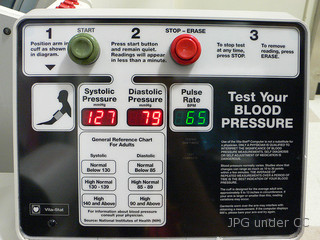Factors affecting BP vary by person. What is the normal blood pressure for women differs from that for men or children.
This is the force exerted by the blood on the walls of the arteries. It is created by the pumping action of the heart. As the heart ventricles contract, the systolic pressure is created and as it relaxes, the diastolic BP is measured.
The systolic pressure is the higher number and the diastolic pressure is the lower pressure. The average ideal blood pressure for adults is 120/80 mmHg. Here, 120 is the systolic and 80 is the good diastolic BP. However, these readings depend on age, sex, and body size.
The systolic pressure normally increases during activities such as running, jogging, swimming, and others because the heart increases its workload during these activities. Nevertheless, it is considered normal if it only rises up to 5 to 10 mmHg. An increase of less than 10 mmHg would still fall within what is the normal blood pressure range. The diastolic pressure on the other hand should not increase significantly during activities because this is the pressure while the heart is at rest.
An increase in the diastolic pressure even when at rest means that there is a cardiovascular incapacity because the heart compensates by working more. What is the ideal BP reading by age is determined by the average BP in all individuals who have no history of hypertension or any risk factors.
The table below shows the ideal readings for all ages!
Normal blood pressure chart
| Age | Normal levels |
| Preteen Newborn | 73/55 mmHg |
| Term Newborn | 73/55 mmHg |
| 6 month’s | 73/55 mmHg |
| 1 year | 90/55 mmHg |
| 3 years | 90/55 mmHg |
| 6 years | 95/57 mmHg |
| 9 years | 95/57 mmHg |
| 12 years | 115/70 mmHg |
| 15 years | 120/80 mmHg |
| Adult | 120/80 mmHg |
| Elderly | 120/80 mmHg – with 5-10 mmHg increase in the diastolic BP |
For adults, a certain range may be normal such as the values below:
| Category | Systolic BP | Diastolic BP |
| Hypotension | 50-89 mmHg | 30-59 mmHg |
| Normal | 90-119 mmHg | 60-79 mmHg |
| High Normal | 120-139 mmHg | 80-89 mmHg |
| Mild high BP | 140-159 mmHg | 90-99 mmHg |
| Moderate high BP | 160 mmHg or higher | 100 mmHg or higher |
| Severe hypertension | 180 mmHg or higher | 110 mmHg or higher |
The average BP in adults also depends on the gender. Generally, women in the premenopausal stage have lower BP than men. Female hormones, which are not present or significantly lower in the amount in men, regulate the blood circulation.
Men also have more vices such as drinking alcohol and smoking, which cause vasoconstriction leading to a higher BP than what women normally have.
People with a large body size also have higher BP than those who are endomorph. This is influenced by the area of the body to be supplied with blood. Since people who have a large framework normally need to receive more blood, the heart pumps more, thus increasing your BP levels.
Normal blood pressure is also affected by emotional factors such as stress, excitement and anxiety. Stress and the like normally increase the BP inside the arteries. However, prolonged emotional stress can potentially lead to hypertension.
Additionally, it is important that the physician or health care professional consider all relevant variables present in a patient to determine if the BP is still normal given other considerations.
Now you know what is the normal blood pressure levels, not forget to keep it in the healthy level!

IM A 62YEAR OLD MALE MY BLOOD PRESSURE READINGS
ARE AROUND 136 83 PULSE 60